Seasoning food is the key to creating stunning tasty dishes. But how to use salt correctly is a skill that still seems to evade many. Even experienced home cooks. This guide explains about the different types of salt and when to use them, alternative seasonings & most importantly – when to salt your food.

This post may contain affiliate links. Please refer to my Disclosures Page for more details.
Salt is probably the most important food there is. There is no cuisine that doesn’t utilise the flavour enhancing properties of salt. And that phrase “flavour enhancing” is important. With few exceptions (like salted caramel), the point of salt is not to add the taste of salt. The point of salt is to make whatever you are adding it to, taste better.
Now I know that there are many people who profess to not like salt. They say they don’t cook with it and never add it to their food. They may well be right.
But I’d put money on those people either a) eating a lot of processed food (so much salt in it already), b) using alternative sources of salt like stock pots and soy without acknowledging that they’re doing the same thing or c) covering everything with so much chilli that the actual flavour of the food is so obscured that it doesn’t matter any more!
So in this guide I’m going to take you through the different kinds of salt that you might come across and explain when you might use them. I’m also going to talk about how to use salt, how to store it and a little about using salt in sweets and baking. I’m also going to take you through the alternatives to using straight up salt and a quick note about using pepper too.
Whilst I have tried to be comprehensive to a point, this quick guide to using salt was supposed to be brief! So whilst I have tried to cover a lot of ground, I haven’t gone into too much detail about each element. If there is something that you want to know more about, let me know in the comments and I will see what I can come up with!
Types Of Salt Explained
You’d think salt was just salt right? It kind of is and kind of isn’t. At its truest and purest, the major constituent of salt is sodium chloride. But there can be other chemicals and minerals in different types of salt which change their taste and texture profiles. The way the salt is harvested will also affect the texture.
And please don’t be scared about the word “chemicals”. We all drink and eat chemicals every day. We need them to survive. If anyone ever tries to scaremonger you about the “nasty chemicals” just gently remind them that water is a chemical.
Sea Salt
Sea salt is what I use the vast majority of the time. I specifically use Maldon Sea Salt. There are several reasons for this. First and foremost, Nigella told me to in the early 2000s and I’ve been doing so ever since. Secondly, I truly believe that it is the most versatile, most natural tasting and best textured salt there is available.
Sea salt is obviously distilled from sea water. It generally contains other minerals like calcium sulphate and magnesium sulphate. It is generally sold as flakes. Saying this, you can now also buy fine ground sea salt which looks much more like table salt.
Sea salt is milder than fine table salt and the flakes don’t compact so you shouldn’t be put off by the quantity of salt given in my recipes looking quite high. 1 tablespoon of sea salt flakes is roughly equivalent to 1-1.5 teaspoons of fine salt.
Because the flakes are quite large, I often crush them in between my fingers as I add them to food. This is especially true if it is being used as a finishing salt like on Poached Eggs or going into something that isn’t going to be heated like my Caesar Dressing.
Homemade Butter Recipe
Table Salt
Table salt is the fine, cheap everyday salt that most of us grew up with. It is refined so that it is almost entirely sodium chloride. It most often has some kind of anti-caking agent added to keep it free-flowing and not clumpy.
I have obviously become a snob in my old age and I almost never use table salt except when I need to use a larger quantity. I’m too cheap to salt pasta water or make brine with Maldon. I also generally feel it has a harsher flavour which does actually add a “salt flavour” to food, rather than just enhancing the food’s flavour.
I also keep cheap salt in the house for cleaning purposes. Used with white vinegar and bicarbonate of soda, it can create quite an impressive abrasive cleaner.
Spaghetti Carbonara with Cream & Peas Recipe
Low Sodium Salt
Low Sodium Salt (“LoSalt”) replaces some of the sodium with potassium. I do not use this salt. Unless you have a valid medical reason for requiring the avoidance of sodium in your diet, replacing it with potassium is not required. And it isn’t “healthier”.
Potassium can actually cause problems in some people with kidney problems and who are taking certain medications so it should be treated with caution.
Rock Salt
Rock salt is mined rather than distilled from water. But this is a little bit of a misnomer. All salt is sea salt. It just happens that the sea has long since gone from the areas where the salt got left behind. I’m talking thousands or hundreds of thousands of years ago, if not more.
Rock salt tends to be found in little hard crystal structures. It is the kind that you want to put into your salt grinder to use. Please don’t add rock salt directly to food. Unless it is a seriously long cooked dish, you’ll risk breaking a tooth.
Like sea salt, you can also buy finely ground rock salt.

Kosher Salt
Kosher salt is not a term used in the UK but it has always intrigued me as I watch a lot of US cookery shows and they always tend to specify “kosher” salt. It turns out to be so named due to its use in curing meats which is a Jewish tradition, rather than the salt being produced under kosher guidelines.
It also turns out to be most of the salt we use in the UK. Sea salt, table salt and rock salt are all considered to be kosher. Kosher means that the salt doesn’t have a bunch of additives. Iodine is a specific no no. Many countries add iodine to their salt to increase its consumption and avoid iodine deficiencies. The UK do not undertake this program and so the majority of our salts don’t contain any added iodine. Ergo, they’re all kosher!
Fleur de Sel
Fleur de Sel is a prized type of French sea salt. It is gently harvested from the top of the water and has fine flower shaped crystals. It is only used in culinary applications and only as a finishing salt.
Salted Caramelised Almond Chocolates – Tin & Thyme
Himalayan Salt
Himalayan salt is merely a type of rock salt which is harvested from a specific region of Pakistan. It has a pinkish colour and whilst it looks fancy in your kitchen and will probably cost you a few more quid, it is doing nothing for flavour, your health or the texture over regular white rock salt. It does look pretty though!
Christmas Bliss Balls – Tin & Thyme
Black Salt
Black salt is rock salt which is fired in a kiln to produce a dark purple salt with a high content of sulphur. The sulphur gives the salt a strong odour and a pungent eggy taste. It is used in some vegan recipes to give a dish that taste of egg that can’t be provided by actual egg.
One Pot Tofu Scramble – Planet Veggie
Flavoured Salts
There are many different flavoured salts available. But it is worth remembering that in every case, the flavour is added to the salt. The salt does not have a flavour.
Smoked Salt
I have a box of Maldon Smoked sea salt flakes in my cupboard but I am rubbish at actually remembering to use it! It is regular sea salt which is smoked over oak. The smell of the salt is really quite powerful in the packet but the flavour is much more subtle when used.
You can use it anywhere that you would use regular salt but only where the smoked flavour will complement the dish. I wouldn’t use it to make Eggy Bread or Yorkshire Puddings but it would work well in dishes like Roast Chicken or my Maple Cherry Tomatoes.
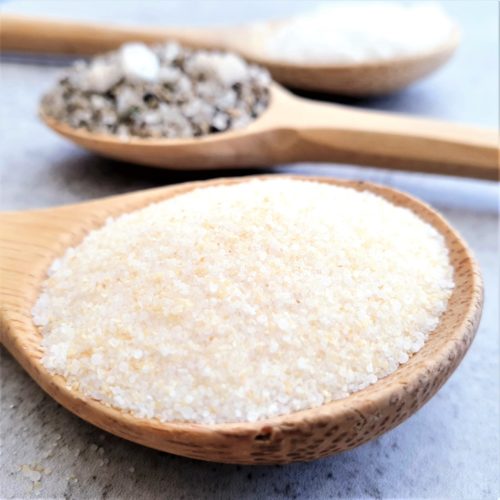
Garlic Salt
Over the last couple of years, I have started using garlic salt almost more than I use regular sea salt flakes. I use it in place of raw garlic in dishes where fresh garlic might catch and burn. I also sprinkle it on fish and meats before cooking. And I especially love it on pork steaks and salmon fillets. It is also useful in dry rubs.
Not all garlic salt is created equal and I am yet to find a “world food aisle” cheap option. In addition to garlic powder and salt, some varieties also contain onion powder which I don’t enjoy. My preferred version is Morrisons own brand. And I’ve started buying it in bulk. Its just a shame they only sell it in little jars.
I really do mean to experiment making my own with ground down sea salt flakes and garlic powder. I feel like it really shouldn’t be too difficult!
Garlic Roasted Sweet Potatoes Recipe
Celery Salt
I only ever think of one use for celery salt and as I don’t like Bloody Mary cocktails, I never buy it! But it does have many other uses. Just like garlic salt, you can sub it for regular salt to add an extra flavouring.
Celery salt is made from ground celery seeds and not the nasty green stuff so adored by misguided dieters and rabbits.
Other Salty Seasonings
When I talked at the beginning of this post about the people who think they don’t eat any salt, the chances are they regularly consume one or more of the following salty substitutes. Every option uses raw salt in its production at some stage.
There are many reasons for using one of these alternatives in a recipe. This is usually because the food needs the flavour that the salt is there to enhance. So by using any of these “alternatives”, you are still adding salt to you food. It is just a secondary process.
Soy Sauce & Fish Sauce
Classic Asian ingredients. Both are fermented sauces, the first made from soy beans and the second from fish. Fish sauce is more of an acquired taste and a little less salty than soy. But both absolutely delicious.
I’ve talked more about both sauces in my Guide to Asian Pantry Ingredients so head over and check out that post. I wouldn’t want to be accused of repeating myself!
Sweet Chilli Salmon Recipe
Miso & Doenjang
Miso and doenjang pastes are, like soy sauce, both fermented soya bean products. The difference is that miso is made with a fungus called koji and hails from Japan. Doenjang is the Korean equivalent but is stronger and more complex than miso. Both options come in a wide variety of strengths and flavours. But they are all pretty salty!
I have again discussed these ingredients in my Asian Ingredients guide so if you didn’t head over to read about soy and fish sauce, maybe head over there now!
Miso Soup with Ginger & Tofu Recipe
To find out about more of my favourite Asian Ingredients, check out my guide to the Top 16 Asian Ingredients which I always keep stocked in my pantry.
I’ve also suggested a whole bunch of recipes to try once your cupboard is fully stocked!
Stock Pots, Bouillon & Stock Cubes
Ready made and concentrated stocks are a staple in the UK, and I believe much of the rest of the world. They are an excellent way of injecting a rich and deep umami (savoury) flavour into your food.
Bouliion simply means broth. Bouillon cubes and stock cubes are exactly the same thing. But one includes a french word and so can cost twice as much. Cubes are concentrated and dehydrated stock. Dehydrated stocks are also sold in tubs.
Stock pots are very reduced but still liquid stocks when generally turn to jelly. I prefer to use a liquid concentrated stock. I buy one made by Knorr which comes in beef, chicken and vegetable varieties.
You can buy a myriad of flavours of stock including the standard chicken and beef (all I ever buy), lamb to ham, pork to fish and vegetable to mushroom plus everything in between. There are many vegan and vegetarian options available too.
You can now also buy low-sodium varieties although I haven’t tried these. Will they pack the same punch or will you need to add extra salt? Is that a bad thing? Potentially not, I’d generally prefer to add my own to taste.
Corned Beef & Potato Bake (Panackelty) Recipe
Marmite & Vegemite
Love em or hate em, they’re salty. Both are a by-product of the brewing industry and are essentially yeast extracts. And both contain added salt. The flavours are distinct and can be used in a number of ways. As they’re both vegan products with a very rich savoury flavour, they can be used to help flavour vegan recipes in place of other stocks and seasoning.
There are distinct groups of people claiming that Marmite is better than Vegemite and vice versa. You can generally split the divide into British vs Australian. Personally I think both products are revolting unless being used in something like a gravy recipe and therefore quite diluted.
The Best Vegan Gravy – Cook Veggielicious
Worcestershire Sauce
Worcestershire sauce has been around since at least the early 19th century. It is a fermented sauce made from anchovies and numerous other ingredients, obviously including salt. The flavour is quite distinctive but not hideously over pungent like Asian fish sauce.
This isn’t a sauce that I use an awful lot but a few drops can really add a tang to a dish. I’ve just started using it in my beef stroganoff and it really makes quite a difference. I’d bet you have a bottle in the back of the cupboard, even if you can’t ever remember buying it!
How to Make Caesar Dressing
Parmesan & Salty Cheeses
Most cheeses contain salt to some extent or another. But some like Parmesan, feta and halloumi are especially salty. Any additional salt should be used with caution when cooking with, or using these cheeses as a garnish, especially halloumi.
Parmesan Arancini – Greedy Gourmet
Bacon & Cured Meats
I’ve talked further below about curing meats with salt and the inevitable outcome is that the finished products are on the saltier side. Bacon, pancetta, prosciutto and other cured meats are therefore excellent to use as a seasoning.
I am always extra cautious about adding other salts when cooking with bacon etc. I find that the saltiness of one product can vary from batch to batch. So I don’t assume but check the seasoning and then add more if I want to.
Bacon & Cherry Bites Recipe
When To Add Salt
During Cooking
It is very rare that a dish doesn’t require salt being added before or during the cooking process. Only salting at the end of cooking often results in that “tasting of salt” rather than “enhancing flavour” thing that I was talking about before. There is a time and a place for that and I’ll discuss that in the next section.
But on the whole the best way to season a dish is as you go. I’ve always done this quite instinctively and written this method into my recipes. But I’ve never known or really given it a name. Laney at Life is But a Dish also teaches this all the time and calls it “seasoning the layers”. So I’m going to steal the phrase! Because this absolutely describes what you should do.
There are several benefits to doing this. First and foremost, the seasoning permeates into the food as you are cooking it. The allows your food to be enhanced from the outside in. Secondly, salt can be used as part of the cooking process.
Salt draws moisture out of other foods. This is how curing meat works. It is why people used to salt and leave aubergines/eggplants so that the bitterness was released (you don’t really need to do this anymore). And why the pink pickled onions in my Chicken Lentil Soup recipe get all nice, soft and juicy.
But the main way that you and I will utilise this power is when cooking onions at the beginning of a recipe. And sometimes mushrooms. When you want onions to soften, go nice and translucent and cook through, you add a little salt.
And then when you throw in the next item in the recipe, you add a little more salt.

When not to Season as you Go
There are some foods that don’t appreciate the salt-as-you-go treatment. Lentils for instance don’t appreciate salty water for cooking. It is best to cook them in plain water or they will never get truly tender.
I would also never add salt to eggs until just before they are about to be cooked. Salting eggs makes the egg loose and easy to whisk together. But it also makes the egg loose! And this can ruin the texture of something which is quite egg heavy. Putting salt on an unbroken yolk will dry it out and give it a nasty texture and speckled look.
(You can however do this on purpose and make cured egg yolks).
Whilst I always salt my pasta water (I didn’t used to and I was wrong!), I never salt water that I’m cooking plain rice in. I find that the rice takes on too much salt flavour which overpowers rather than enhances the subtle taste of rice. Some rice like sushi rice is best seasoned after cooking.
Vegetarian White Bean Chili Recipe
Finishing Salt
Sometimes it isn’t possible to salt a food from the inside out. This is especially true of quick cooked foods. I never bother to salt my egg poaching water. I think it is a waste of salt. But I always, and I do mean always, sprinkle a little sea salt over my cooked eggs.
There are other instances such as when I cook a steak and then slice it to serve. I will make sure to sprinkle a little salt over the cut insides of the steak, especially if it is very thick and the outside seasoning is unlikely to have fully permeated the meat as it cooks. This is also true for any piece of meat or fish which is cooked and then sliced.
And then consider the act of using sauces and dips. Dunking some freshly steamed dumplings into a dipping sauce of soy sauce and vinegar is effectively finishing the dish with salt. The only difference is that the person eating does the seasoning rather than the person cooking it.
How to Poach Eggs
Using Salt In Sweets & Baking
Ew! Salt in a cake! Oh little do you know! So many people are screamish about this as a concept. And these same people have been chowing down on baked goods packed with salt their whole lives. Just because a recipe doesn’t call itself “Mr Kiplings Salted Angel Slices” or “Original Glazed Salty Krispy Kreme” doesn’t mean that there isn’t salt in there! Spoiler alert, there is!
This is because sweet goods need their flavour enhancing too.

In the Background
So salt in the background is common. And you wouldn’t know it was there. But you’d certainly know if it wasn’t.
At this point I admit that I sort of made an omission when I listed the salt alternatives above. Because many leavened baked goods contain baking powder, bicarbonate of soda (bicarb/baking soda/sodium bicarbonate) or cream of tartar.
All of these products contain sodium or potassium. Baking powder is actually a mixed product containing bicarb/cream of tartar and a starch like cornflour. And you’ll remember that salt is primarily sodium chloride and potassium is used to replace the sodium in low-sodium products. So in effect, they all have a salty taste.
So often you will see a sweet recipe like my Chocolate Muscovado Cake or Victoria Sponge Cake which doesn’t have sea salt flakes listed as an ingredient. Instead the bicarbonate of soda and baking powder/self raising flour is doing the flavour enhancing. This is why you should be careful not to overuse raising agents when baking.
Peach & Ginger Crumble Recipe
Salty Sweets
But then sometimes we do want a salty flavour to be more obvious. Salted caramel has become a huge flavour over the last few years. It is still the case that we have been eating salted caramel for many many years but now we’ve added a label and often, a touch more salt.
There are other salty sweets which are popular around the world. The most obvious one that come to mind is “salmiak liquorice” or “salty liquorice” which is eaten across the nordic countries and is especially popular in Finland. I honestly don’t want to dwell on this too long as liquorice and anise in general has very strong links with my gag reflex.
Sticky Toffee Cupcakes Recipe
Using Salt to Brine, Pickle and Cure
Salt is not just a flavour enhancer but an ancient preservative too. It is used in various different ways. Brining however is a way to help food keep moist during cooking whilst enhancing flavour.
Wet Brining with Salt
Wet brining involves making a solution with salt, water and possibly other flavourings then immersing the main ingredient in the solution for some time. Both the salt and water make their way into the ingredient and the salt means that is is retained after the ingredient is taken out of the solution, dried and cooked.
I say “ingredient” although we are largely talking about meat here. Fish can also be wet brined. Vegetables are sometimes soaked in a wet brine before being dry brined.
The only time I tend to cook with the method is when making my turkey for Christmas every year. Anyone that tells you turkey is dry is simply not cooking it well. But you can also dry brine whole chickens, chicken pieces, pork and beef, etc.
Bacon can be wet brined. When pork is fully brined, it becomes bacon. If we’re talking about the hind leg of pork, then this brined bacon is called gammon. I’ve talked about this distinction at more length in my Ginger Glazed Ham post. But to confuse matters further, much bacon is dry brined…
How to Roast Turkey (Wet Brined Crown)
Dry Brining with Salt
Dry brining is exactly what it sounds like. You cover your ingredient, usually meat again, in salt well before cooking and then leave it to soak in. You don’t use water and you don’t rinse it off.
There are similarities with this method and curing but the aim here is to flavour the dish, not to dehydrate and preserve it.
As mentioned above, mush of the bacon we buy is dry brined. Confusingly, this is often called “dry cured”. But really a cure is removing almost all the moisture which is not the aim with bacon. The texture is changed a little but mostly it is about imparting flavour into the meat. My preference is a wet brined bacon.

Pickling with Salt
You can pickle anything with a solution of salt, vinegar and often, sugar. The salt that you use needs to not contain any additives. So table salt with its anti-caking agents is out. But regular sea salt, rock salt or pure table salt are all good.
I am not a huge fan of pickling. I don’t enjoy things being too sour and I don’t use a lot of vinegar. (Never on my chips – argh!). But I do make a very quick pickle with red onions. I use salt, sugar and lemon juice on finely sliced red onion. This takes the harsh flavour out of the red onion and is perfect for topping all manner of recipes like this soup.
Easy Pickled Red Onions (In 5 Minutes!)
Curing with Salt
Curing involves allowing salt to draw the moisture out of a product and replacing that water with some of the salt. It is water where bacteria grows and so without the water content, the product doesn’t spoil.
The process usually makes the product firmer and more dense in texture. And obviously, saltier in flavour. Common examples of cured products include salami, prosciutto/serrano ham, breasola (Italian cured beef) and salt cod.
Beetroot Cured Salmon – Lost in Food
What To Do If You Add To Much Salt
Uh-oh! You can taste the salt and you didn’t want to! You’ve gone to far and now your food tastes like you’re licking the sea. Oops! (Don’t worry, we’ve all been there!)
You can’t really take salt away. But there are some remedies which might help. Which ones you try will really depend on what it is that you’ve over salted.
Get someone else to taste it
Actually you might be over panicking. Get a second opinion. You might have just been staring at it too long.
Rinse it off
Can you run whatever you’re cooking under the tap a little then reheat/glaze it? This might help if you’re talking about grilled or pan fried meat or fish. Don’t try this with anything porous like potatoes.
Add creaminess
Adding milk or cream to a dish can tone down the salty flavour. This can be especially helpful in soups, stews and curries. (It helps if you’ve added too much chilli too). Yoghurt is another option. The thicker and creamier your product, the more it is going to help whilst diluting your dish less.

Add acid
Again, depending on what you’re cooking, adding a strong flavour like vinegar or lemon juice can overpower the saltiness.
Add a starch
Throwing some pasta, rice or potato in can help to soak up some of the extra salt.
Double the recipe but don’t add any more salt
Ok so you’ll end up with more food but at least it’ll all be edible. And you can probably freeze half anyway.
Dilute, don’t reduce
Adding more liquid will help to dilute the salty flavour. It will also dilute the texture. But reducing the food any further than you need to will simply re-concentrate the salt flavour so don’t so this either. You can consider thickening a sauce with cornflour instead.
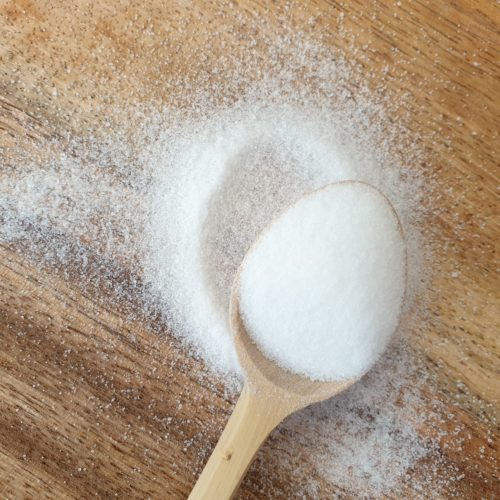
How to Store Salt
Away from moisture. This is the golden rule. Salt will then pretty much last forever. It is a natural preservative after all.
This usually means that I keep my salt in its box in a cupboard. If I have opened it, I use a bag clip to keep the inner plastic bag sealed. I do however keep a small open pot of salt next to my hob. This is where I do 90% of my seasoning.
The rest of the time, I can either move the pot to where I am working or use my legs and my hands to carry it!
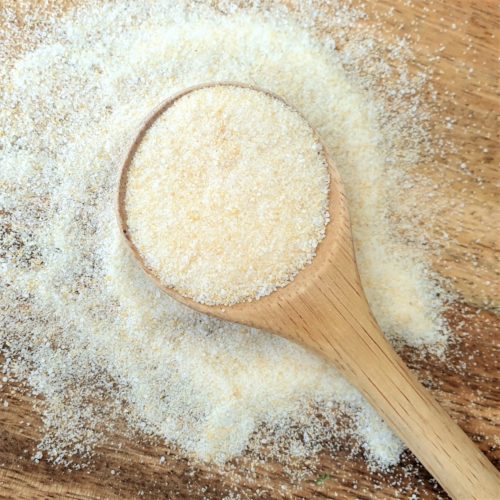
A Short Note About Pepper
Pepper is the linguistic bed fellow of salt. And often the accompaniment on the table. Sometimes even within the same dispenser. But they have entirely different uses. Remember how I keep banging on about salt being a flavour enhancer and not a flavour? Well pepper is a flavour. Specifically, pepper is a spice.
I very rarely use pepper. I don’t generally enjoy the flavour of spice that it imparts. But I do use it however. Both my Southern Baked Chicken Wings and Fun Guo Chinese Dumplings both use pepper as a flavour. The wings use cracked black pepper and the dumplings use ground white pepper. This is because they have different flavours.
So whilst I wouldn’t say don’t use pepper because if you want to grind it over everything you eat then of course you should. But perhaps I can persuade you to consider its usage a little more. Not everything needs pepper. After all, you wouldn’t sprinkle paprika or cumin over any and all food willy nilly!
Southern Baked Chicken Wings Recipe
Fun Guo (Steamed Chinese Pork Dumplings Recipe)
Salt in Summary
So hopefully what you have taken away from this post is that sea salt is amazing, you should season as you go and things are generally supposed to taste better, not salty!
So I’ve tried to be pretty comprehensive. Do you think I’ve forgotten anything? Do you have some other tips and tricks to add that I’ve missed out? Head down to the comments section and let me know!

Pin How to Use Salt For Later
Hit one of the share buttons to save this page to your Pinterest boards so you can come back and find it at anytime!

Keep Up to Date
Make sure you SUBSCRIBE to my newsletter and avoid missing out on any of my newest and bonus content. Don’t worry, I promise not to spam you or bombard you too often. Plus you’ll receive a copy of my FREE 7 Day International Meal Plan!
Also please don’t forget to follow me over on my social media channels over at Facebook, Twitter, Instagram and Pinterest. I love to interact with my followers and I’d love you to share my content with your friends too.




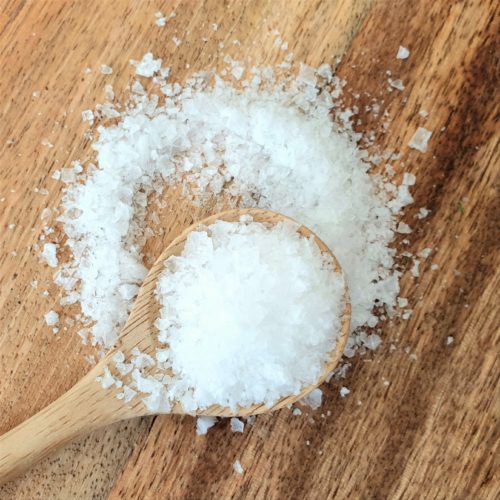
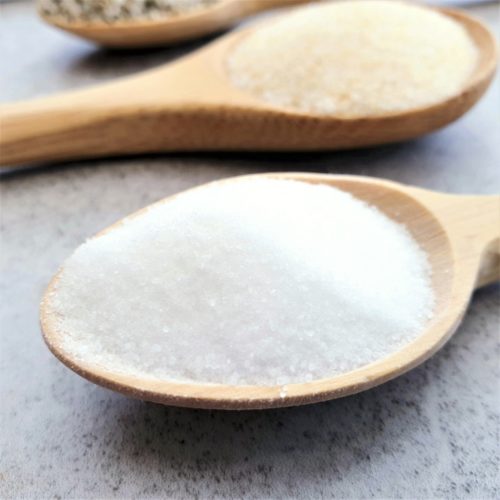
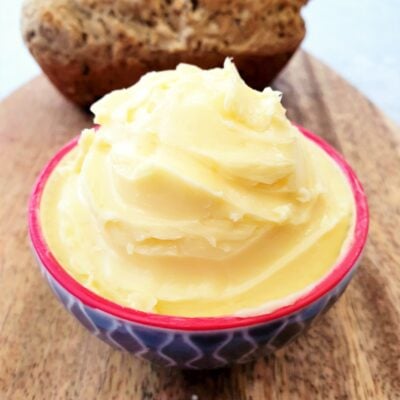
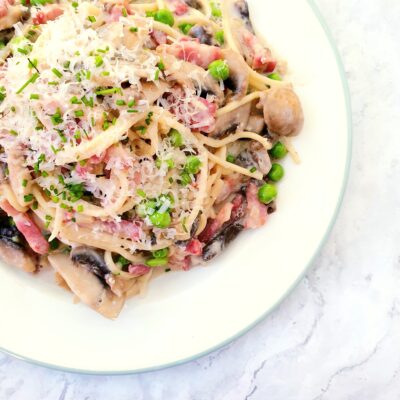



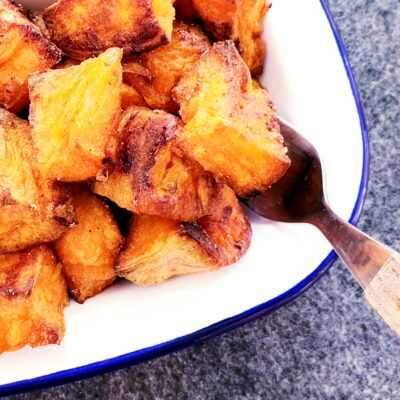

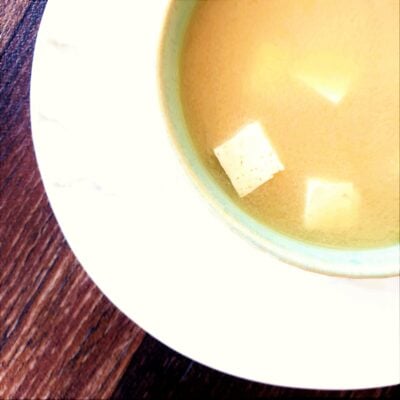

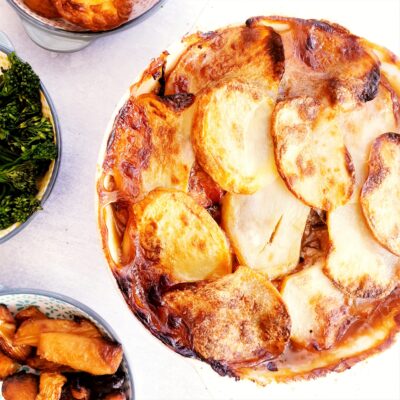

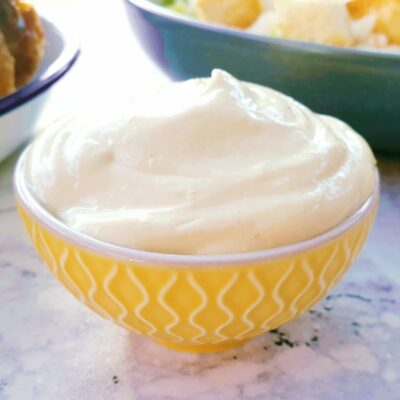


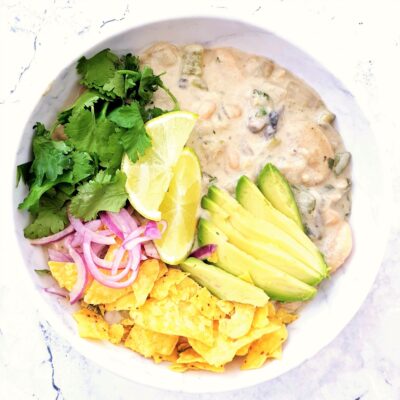
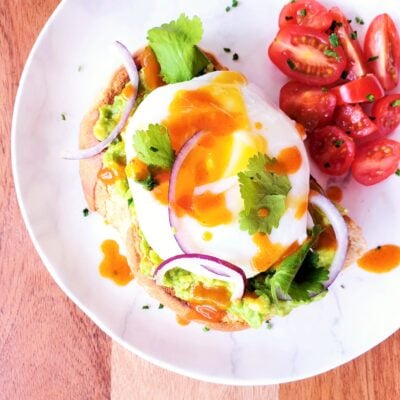
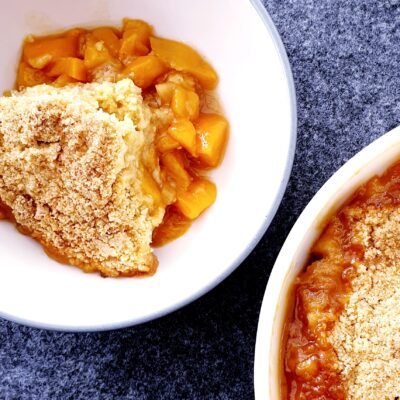


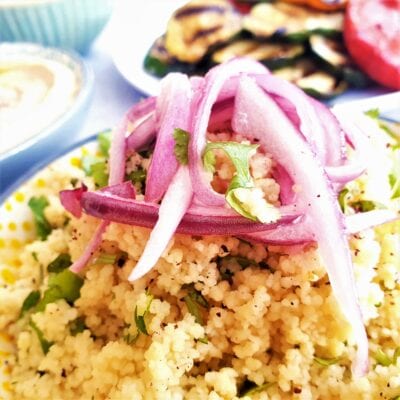


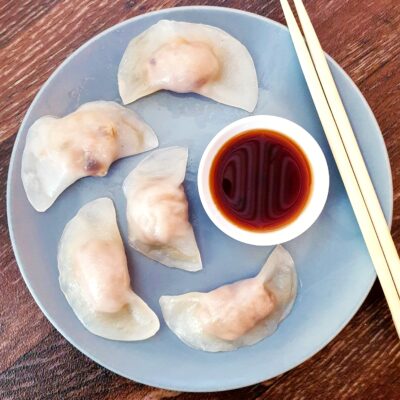
Lesley says
Great post Chloe, very informative and thank you for including our cured salmon recipe. I’m laughing at your comment about smoked salt – like you I love it, but very often forget to add it! I’ve moved tub from cupboard to beside job in attempt to rectify problem. I have a friend who never adds salt to her food – her food is dreadful!
Chloe says
Thanks! Oh we all have those products don’t we. They live there with the best of intentions. I have some thyme jelly that I bought at a trade show. Its delicious but I haven’t used it. I think its been there for at least 5 years!
Kate - Gluten Free Alchemist says
Wow! That has to be the most extensive guide on salt… ever! Salt if used well is an essential enhancer. But you’ve answered so many questions. Definitely a go-to guide!! x
Chloe says
Lol yes it certainly grew and grew in a way that I hadn’t planned! I’m glad the post was a help!
Choclette says
You’re a complete star and have answered the question I have asked so many people without ever getting a proper answer. Loads of American bloggers use kosher salt and I’ve asked and asked what it is. But none of them actually seem to know. Brilliant, thank you. Fabulous guide to the salty world of food too. Or should I say the foodie world of salt?
Chloe says
Oh I know, its been bothering me for years too!!!!
Mandy says
This is definitely the most comprehensive guide to salt I’ve ever seen! Well done Chloe and thanks for linking to my gravy recipe.
Chloe says
Me too!!!!
Janice says
Very comprehensive! I’m never going to agree with you about pepper, I just love it. In fact, I’d generally use less salt and more pepper. But then if we were all the same life would be very boring. Some lovely recipes too.
Chloe says
Ha! I think using pepper is fine if it’s considered and you want to. I just think an awful lot of people use is because they’ve always been told to salt and pepper food so they do it by rote rather than consciously, or because they actually like it!
Michelle Rolfe says
Great post Chloe! So many people use just table salt and don’t understand why their food tastes salty. Great explanations! And thanks for including of beetroot cured salmon! Michelle
Chloe says
Drives me bonkers!
Michelle says
Wow, what a comprehensive article on salt! Very handy because there are so many types that can lead to confusion!
Chloe says
Thanks! I do love a good research project!